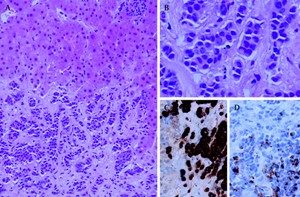
Cirrhosis of the liver is a progressive liver disorder in which scar tissue forms inside the organ and replaces healthy tissue. The scar tissue forms fibrous masses (a condition called liver fibrosis) and, over time, causes degradation of liver function eventually leading to complete liver failure and death.
Cryptogenic cirrhosis is cirrhosis with no readily identifiable cause (hence the name –
resembles alcoholic cirrhosis of the liver, but patients with cryptogenic cirrhosis are not problem drinkers or alcoholics.
Cryptogenic cirrhosis is one of the main causes of liver transplants. This is because treatment of cirrhosis of the liver revolves around treating the cause of the disease in order to arrest its progression before too much damage has been done. When the cause of the disease is unknown, this is very difficult to do. Progression of the cirrhosis to the point where a liver transplant becomes necessary is therefore more common than in cases of cirrhosis where the cause can be clearly identified.
NASH
It’s believed that a precursor to cirrhosis of the liver is sometimes nonalcoholic steatohepatitis (NASH). This refers to a buildup of fat deposits in the liver causing swelling and inflammation of the organ, caused by something other than alcohol abuse. NASH can be identified in blood tests and through use of medical imaging techniques such as ultrasound before any overt symptoms appear. The progression from NASH to cirrhosis of the liver is often slow and gradual. In all cases, NASH is a cause for concern when identified because of the possibility that it may lead to cirrhosis of the liver.
Symptoms
The symptoms of cryptogenic cirrhosis are essentially the same as those of any other form of cirrhosis of the liver. They include swelling and pain in the abdomen, fatigue, weakness, nausea, vomiting, loss of appetite, bloody stools, unexplained loss of weight, jaundice, rashes, and discoloration of the skin. However, in the early stages of the disease no symptoms may occur at all.
Causes
Although the cause of cryptogenic cirrhosis is not easily identified, cases in which the cause was eventually determined suggest that obesity and type 2 diabetes –
Treatment
There is no direct treatment for cirrhosis of the liver except a liver transplant, which is never undertaken except in response to the final stages of the disease. Indirect treatment to halt the progression involves treatment of the underlying condition, such as alcoholism, obesity, or diabetes. With cryptogenic cirrhosis, the cause is unknown (except that alcohol abuse can be ruled out), which makes treatment difficult.
With patients who suffer from obesity or diabetes, treatment of those conditions may arrest the cirrhosis as well, but not always.
Prognosis
Because the cause of cryptogenic cirrhosis is unknown, prognosis is somewhat worse than with cases where the cause of the illness can be identified. Cryptogenic cirrhosis is very likely to progress to the stage where a liver transplant becomes necessary, and even then, new scarring often develops on the transplanted liver. Unless the cause of the illness can be found or at least guessed correctly, prognosis is guarded to poor.
Cryptogenic cirrhosis can strike victims of any age group, theoretically. However, most cases occur with patients who are over age sixty.